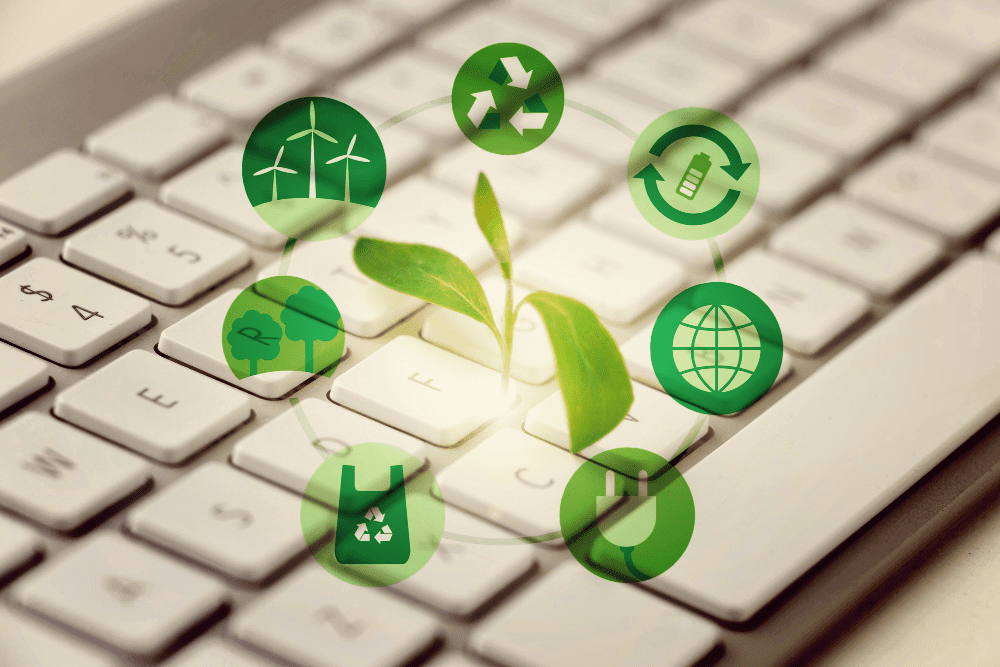Carbon Footprint in the Digital Age: The Environmental Impact of the Internet
The carbon footprint is a cost to the environment that is frequently disregarded in the digital era due to our dependence on the internet and technology. Every email received, every movie streamed, and every web page visited necessitates the processing and storing of information by data centers, which results in high energy usage and carbon emissions. This influence has increased due to the development of devices, cloud computing, and data storage facilities. Using renewable energy sources, encouraging digital simplicity, and improving data centers for energy efficiency are critical measures in mitigating this. Conscious consumption practices can also help to lessen the digital carbon footprint and promote a more sustainable online environment. Some examples of these practices include cutting back on pointless emails, streaming lower-resolution content, and consolidating devices.

The development of the internet has completely changed how we communicate, work, and live. But even as we enjoy the advantages of living in a connected society, we must carefully consider the environmental cost of our digital lifestyle. This article explores the hidden environmental effects of our online activity as it dives into the relationship between the internet and carbon footprint.
What is Carbon Footprint?
The carbon footprint is the total quantity of carbon dioxide (CO2) emissions connected with all of a person’s or entity’s actions. The term “carbon footprint” is defined as follows in an article from 2011, “A measure of the total amount of carbon dioxide (CO2) and methane (CH4) emissions of a defined population, system or activity, considering all relevant sources, sinks and storage within the spatial and temporal boundary of the population, system or activity of interest. Calculated as carbon dioxide equivalent using the relevant 100-year global warming potential (GWP100).”

The carbon footprint, also known as the greenhouse gas footprint, serves as a metric for assessing the overall quantity of greenhouse gases released during a specific activity, the production of a particular product, or the operations of a company or country. Typically quantified in tonnes of emissions (CO2-equivalent) per unit of measurement, such as per year, per person, per kilogram of protein, or per kilometer traveled, carbon footprints offer a comprehensive view. For products, the carbon footprint encompasses emissions throughout the entire life cycle, spanning from production and supply chain processes to eventual consumption and disposal. Similarly, an organization’s carbon footprint considers both direct and indirect emissions, categorized as Scope 1, 2, and 3 under the Greenhouse Gas Protocol, a standard for carbon accounting in organizational settings. The carbon footprint is connected to an older idea called the ecological footprint. An ecological footprint measures the overall land needed to support an activity or a group of people. It considers environmental effects like water use and the land used for making food. On the other hand, a carbon footprint is often described by its weight, such as tons of CO2 or CO2 equivalent per year. This concept was developed at the University of British Columbia in the early 1990s by Canadian ecologist William Rees and Swiss-born regional planner Mathis Wackernagel.
Significance of Carbon Footprint
Understanding and lowering carbon footprints has grown in importance in the context of climate change and environmental degradation. A carbon footprint is the total amount of greenhouse gases emitted by an individual, organization, product, or activity, particularly carbon dioxide (CO2). Taking action to understand and reduce these footprints adds to climate change mitigation. Monitoring and lowering emissions not only assist save scarce resources but also encourage energy efficiency, reducing the environmental effects of excess carbon output. Individuals and corporations must work together to adopt sustainable behaviors, invest in renewable energy, and make informed decisions for a better planet. Recognizing the significance of carbon footprints highlights our obligation to create a sustainable and resilient future for future generations. Carbon footprints are essential for several reasons:
Climate Change Mitigation: Carbon footprints are directly linked to the emission of greenhouse gases, particularly carbon dioxide (CO2), which contribute to climate change. By measuring and reducing carbon footprints, individuals, businesses, and governments can play a role in mitigating the impacts of global warming.
Resource Conservation: Monitoring carbon footprints involves assessing energy consumption and resource use. By identifying areas of high carbon intensity, individuals and organizations can find opportunities to reduce their environmental impact, leading to more efficient use of resources.
Sustainable Practices: Assessing and managing carbon footprints encourages the adoption of sustainable practices. This includes the use of renewable energy sources, energy-efficient technologies, and responsible consumption patterns, contributing to the overall sustainability of activities and operations.
Regulatory Compliance: Many countries and regions have started implementing regulations and standards aimed at reducing carbon emissions. Understanding and managing carbon footprints is essential for compliance with these regulations, helping organizations avoid legal issues and potential fines.
Corporate Social Responsibility (CSR): For businesses, addressing carbon footprints is a key aspect of corporate social responsibility. Consumers are increasingly conscious of environmental issues, and companies that demonstrate a commitment to reducing their carbon impact can enhance their reputation and attract environmentally conscious customers.
Risk Management: Climate change poses risks to various industries, such as agriculture, real estate, and insurance. Assessing and addressing carbon footprints is a proactive measure that can help businesses anticipate and manage climate-related risks.
Cost Savings: Implementing energy-efficient practices to reduce carbon footprints often leads to cost savings. By optimizing energy use and adopting sustainable technologies, businesses and individuals can cut down on utility expenses and improve overall efficiency.
Global Cooperation: Carbon footprints are a global concern that requires international cooperation. By recognizing the importance of carbon footprints, individuals and organizations contribute to a collective effort to address climate change and promote global environmental sustainability.
Effect of the Internet on Carbon Footprint
Global energy systems are currently confronting the biggest unknowns and problems in the last fifty years, according to British Petroleum’s 2022 World Energy Statistics Review. Since the previous ten years, the pace of increase in global carbon emissions has peaked, and there is a growing mismatch between the supply and demand for carbon reduction initiatives in society. Research has played a crucial role in advancing our understanding of how the digital economy influences carbon emissions. Nonetheless, a prevalent limitation lies in the oversight of the broader implications of the digital economy. It is inaccurate to conflate the carbon emissions associated with digital technology with those attributed to the entire digital economy. Our growing dependency on digital technologies has raised serious concerns about how Internet usage affects the carbon footprint. The Internet’s environmental impact is influenced by multiple aspects. These include:

Block Chain Technology
The use of digital encryption networks in blockchain technology is another source of demand for electricity. For this technology to trace and validate digital transactions, a significant quantity of electricity is required. The blockchain-based digital currency known as Bitcoin uses an enormous amount of electricity. Millions of tons of carbon emissions will result from this. The digital economy and high carbon emissions seem to go hand in hand.
Data Centers and Energy Consumption:
Significant amounts of energy are needed for data centers to function, as they handle and store enormous volumes of digital data. Carbon emissions rise as a result of high electricity usage from cooling systems, servers, and other infrastructure elements. This electricity is frequently derived from non-renewable sources.
Electronic Devices Production
Resources are used extensively in the procedures used in the manufacturing of electronic equipment, including servers, laptops, and smartphones. These gadgets have a significant environmental impact because of the carbon emissions they produce during manufacturing, shipping, and disposal.
Network Infrastructure
Energy is needed for network equipment and data transmission, as well as other components of the infrastructure supporting the Internet. A rise in energy consumption and carbon emissions is a result of network infrastructure growth to handle the growing amount of Internet traffic.
Digital Content Streaming
Data transmission has increased as a result of the widespread use of internet streaming services for music, movies, and other information. High-quality video streaming needs a lot of data bandwidth, which increases energy use and carbon emissions, especially in data centers that use non-renewable energy sources.
E-Waste
Electronic garbage, or “e-waste,” is a byproduct of disposing of electronic gadgets and frequently finds its way into landfills. Ineffective disposal techniques increase the carbon footprint by releasing hazardous materials into the environment and polluting it.
A multifaceted strategy is needed to address the effect of Internet usage on carbon footprint, including industry-wide activities to encourage sustainability in digital behaviors as well as individual awareness campaigns. Several steps could be taken to lessen the carbon footprint that comes with using the Internet and mitigate its negative effects on the environment:
Energy-Efficient Data Centers
Encouraging the use of energy-efficient technologies and renewable energy sources in data centers can help minimize the carbon footprint of digital infrastructure.
Device Recycling and Circular Economy
Reducing the environmental impact of device production and disposal can be achieved by supporting recycling programs and the implementation of a circular economy for electronic gadgets.
Efficient Network Design
One way to lessen the carbon footprint of data transmission is to optimize network infrastructure for energy efficiency and encourage the use of low-energy transmission technology.
Digital Literacy
Informing consumers about how their online behavior affects the environment can promote more environmentally friendly habits, such cutting back on wasteful data use and setting up gadgets to use less energy.
Renewable Energy for Internet Infrastructure
The carbon footprint associated with Internet usage can be greatly reduced by supporting the switch to renewable energy sources for data centers and Internet service providers.
Sustainable Initiatives of PCBWay in PCB Manufacturing
PCBWay is a market leader in printed circuit board (PCB) production and assembly. PCBWay is a global company that provides a user-friendly online platform that allows consumers, corporations, and professionals to design, prototype, and produce PCBs for diverse electrical applications. The company is known for its cutting-edge technology, efficient manufacturing processes, and short turnaround times. Aside from its core services, PCBWay prioritizes environmental responsibility, including sustainable methods throughout its operations to help reduce the carbon footprint of electronics manufacturing. PCBWay continues to play an important position in the ever-changing world of electronic design and production as a trusted partner for PCB solutions. Let’s examine the sustainable methods used by PCBWay in the production of PCBs;

Lead-Free PCBs: PCBWay offers lead-free PCB options, aligning with global efforts to eliminate hazardous substances and reduce the environmental impact of electronic waste.
Halogen-Free Laminates: To address environmental and health concerns related to halogen-containing compounds, PCBWay provides halogen-free laminate options for their PCBs.
RoHS Compliance: PCBWay ensures that their PCBs comply with the Restriction of Hazardous Substances (RoHS) directive, which restricts the use of hazardous substances in electronic products.
Energy-Efficient Manufacturing: The company focuses on energy-efficient manufacturing processes, including using energy-saving equipment and optimizing production line layouts to reduce energy consumption.
Waste Reduction and Recycling: PCBWay implements waste reduction strategies and encourages recycling programs to minimize waste generation and promote responsible waste management.
Eco-Friendly Materials: The company offers PCB options that utilize eco-friendly materials, contributing to a reduced environmental impact.
Environmental Certifications: PCBWay may obtain relevant environmental certifications to demonstrate their commitment to sustainable practices and compliance with environmental standards.
Circular Economy Approaches: PCBWay may support circular economy principles by encouraging PCB repair and refurbishment, thus prolonging the life of PCBs and reducing e-waste.
Responsible End-of-Life Management: The Company may provide guidance to customers on proper end-of-life management for their PCBs, including recycling options to prevent hazardous materials from being disposed of improperly.
PCBWay’s Sustainable Sponsorship Initiatives
The company’s commitment to responsible corporate citizenship and environmental care is demonstrated by PCBWay’s Sustainable Sponsorship Initiatives. PCBWay goes above and beyond the production of circuit boards by actively sponsoring sustainability-focused projects. A more sustainable future is what the sponsorship programs seek to empower and encourage through creative solutions. PCBWay’s sponsorship demonstrates the company’s understanding of the value of sustainability in the electronics sector, from supporting projects that address environmental concerns to implementing eco-friendly manufacturing techniques.
CELLSIUS Project H2
With the support of PCBWay, a group of engineering students from ETH Zürich have been designing, constructing, and testing a hydrogen-battery hybrid powertrain for a light aircraft made by Lightwing, the AC4. The goal is to lower carbon emissions. Their dedication lies in constantly striving to enhance the environmental friendliness of the aviation sector. We intend to demonstrate a sustainable and environmentally friendly approach to aviation and help reduce the carbon footprint by creating and deploying a hydrogen-battery hybrid engine. PCBWay helps them to prototype more quickly. They may design custom PCBs that satisfy their unique requirements, test them more quickly, and improve them until they function flawlessly by working with PCBWay.
Conclusion
In the digital age, responsible decision-making and group action are necessary due to the internet’s environmental impact, as seen by its carbon footprint. Significant increases in energy consumption, pollution, and resource use have been brought about by the explosion of online activity and the quick development of digital infrastructure. A comprehensive strategy that incorporates sustainable behaviors, energy-efficient technologies, and user knowledge is needed to address the internet’s carbon impact. It becomes our common duty to strike a balance between the preservation of the environment and our digital advancements as we negotiate the constantly changing terrain of connectivity and technology. We can work to create a more environmentally friendly digital future that respects the limited resources of our world by embracing sustainable solutions, supporting renewable energy sources, and encouraging a culture of digital mindfulness.






